LG Electronics USA GW520 Cellular/ PCS GSM/ EDGE Phone with Bluetooth User Manual GW520 Eng 0212 indd
LG Electronics USA Cellular/ PCS GSM/ EDGE Phone with Bluetooth GW520 Eng 0212 indd
Users Manual

ENGLISH
GW520
USER GUIDE
Some of the contents in this manual may differ from your phone
depending on the software of the phone or your service provider.
Disposal of your old appliance
1.
When this crossed-out wheeled bin symbol is
attached to a product it means the product is
covered by the European Directive 2002/96/EC.
2. All electrical and electronic products should be
disposed of separately from the municipal waste
stream via designated collection facilities appointed
by the government or the local authorities.
3. The correct disposal of your old appliance will help
prevent potential negative consequences for the
environment and human health.
4. For more detailed information about disposal of your
old appliance, please contact your city office, waste
disposal service or the shop where you purchased
the product.

Part 15.21 statement
" Change or Modifications that are not expressly approved by the manufacturer could void
the user's authority to operate the equipment. “
Part 15.105 statement
This equipment has been tested and found to comply with the limits for a class B digital
device, pursuant to Part 15 of the FCC Rules.
These limits are designed to provide reasonable protection against harmful interference in
a residential installation. This equipment generates uses and can radiate radio frequency
energy and, if not installed and used in accordance with the instructions, may cause harmful
interference to radio communications. However, there is no guarantee that interference will
not occur in a particular installation. If this equipment does cause harmful interference or
television reception, which can be determined by turning the equipment off and on, the user
is encouraged to try to correct the interference by one or more of the following measures:
- Reorient or relocate the receiving antenna.
- Increase the separation between the equipment and receiver.
- Connect the equipment into an outlet on a circuit different from that to
which the receiver is connected.
- Consult the dealer or an experienced radio/TV technician for help.
This device is not intended for sale in the USA.

Part 15 Class B Compliance
This device and its accessories comply with part15 of FCC rules.
Operation is subject to the following two conditions:
(1) This device & its accessories may not cause harmful interference.
(2) This device & its accessories must accept any interference received,
including interference that may cause undesired operation.
Body-worn Operation
This device has been tested for typical body-worn operations
with the distance of 0.79inches (2.0cm) from the user’s body.
To comply with FCC RF exposure requirements, a minimum separation distance
of 0.79inches(2.0cm) must be maintained from the user's body.
Additionally, Belt clips, holsters & other body-worn accessories may not contain
metallic components.

Set up
11
GETTING TO KNOW YOUR
PHONE
1. INNER CAMERA LENS
2. END/POWER KEY
° Ends or rejects a call. Turns the phone
on/off. Press once to return to the
standby screen.
3. CLEAR KEY
4. CALL KEY
° Dials a phone number and answers
incoming calls.
Placing a heavy object on the phone
or sitting on it while it is in your pocket
can damage the phone's LCD and touch
screen functionality.
5. CHARGER, CABLE, HANDSFREE
CONNECTOR
To connect the USB cable, wait until
the phone has powered up and has
registered to the network.
6. SIDE KEYS
° When the screen is idle: volume of key
tone.
° During a call: volume of the earpiece.
7. MICRO SD MEMORY CARD SOCKET
8. LOCK/ UNLOCK KEY
9. MULTITASKING KEY
10. CAMERA KEY

Set up
12
INSTALLING THE USIM AND
BATTERY
1. REMOVE THE BATTERY COVER
Press and hold down the battery release
button at the top of the phone and lift off
the battery cover.
2. REMOVE THE BATTERY
Hold the top edge of the battery and lift it
from the battery compartment using the
battery cover.
Do not use your fingernail when
removing the battery.
Do not remove the battery when the
phone is switched on, as this may
damage the phone.
3. INSTALL THE USIM CARD
Slide the USIM card into the USIM card
holder. Make sure that the gold contact
area on the card is facing downwards. To
remove the USIM card, pull it gently in the
opposite direction.

Set up
13
4. INSTALL THE BATTERY
Insert the top of the battery first into the
top edge of the battery compartment.
Ensure that the battery contacts align with
the terminals on the phone. Press down
the bottom of the battery until it clips into
place.
5. REPLACE THE COVER
Place the cover over the battery and slide
up into position.
6. CHARGING YOUR PHONE
Slide back the cover of the charger socket
on the side of your GW520. Insert the
charger and plug into a mains electricity
socket. Your GW520 will need to be
charged until a message reading "Battery
full" appears on screen.

Set up
14
MEMORY CARD
INSTALLING A MEMORY CARD
You can expand the memory space
available on your phone using a memory
card.
1. Remove the battery cover as shown on
page 14.
2. Slide the memory card into the slot at
the top, until it clicks into place. Make
sure that the gold contact area is facing
downwards.
FORMATTING THE MEMORY CARD
Your memory card may already be
formatted. If your card isn't already
formatted, you will need to do so before
you can begin using it.
1. From the standby screen select , then
touch Setting and choose Phone
settings.
2. Touch Memory manager then chose
External memory.
3. Touch Format and then confirm your
choice.
4. Enter the password, if one is set, and
your card will be formatted and ready
to use.
To change your default storage
destination, open Memory manager from
the Phone settings menu and select
Primary storage settings.
If your memory card has existing content
on, it will automatically be filed in the
correct folder, for example, videos will be
stored in the My Videos folder.

Set up
15
TRANSFERRING YOUR CONTACTS
To transfer your contacts from your USIM
to your phone:
1. From the Communicate tab, select
Contacts and choose Settings.
2. Touch Copy.
3. Choose Handset to USIM and touch
Done.
4. Choose Select all or choose names one
by one and touch OK.
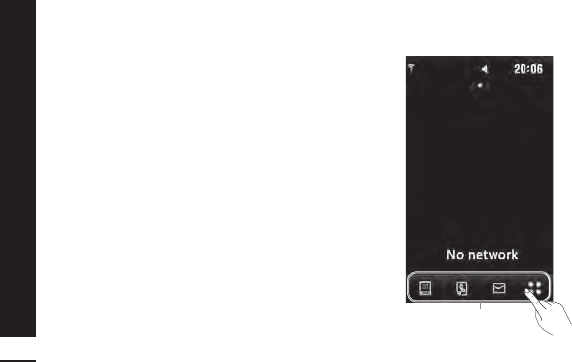
Your standby screen
16
Whenever your GW520 is not in use it will
return to your home screen. From here you
can access all menu options, make a quick
call and view the status of your phone - as
well as many other things.
TOUCH SCREEN TIPS
The home screen is also a great place to
get accustomed to the touch screen.
To select an item, touch the icon
accurately. Your GW520 will vibrate
slightly when it recognises you’ve touched
an option.
To scroll through lists, touch the last item
visible and slide your finger up the screen.
The list will move up so more items are
visible.
° There’s no need to press too hard, the
touchscreen is sensitive enough to pick
up on a light yet firm touch.
° Use the tip of your finger to touch the
option you require. Be careful not to
touch any other keys around it.
° When the screen light is off, press the
Unlock/Lock key on the right hand side to
restore the home screen.
° Don’t cover the phone with a case or
cover as the touchscreen will not work
with any material covering it.
Quick keys

Your standby screen
17
THE QUICK KEYS
The quick keys provide easy, one-touch
access to your most used functions.
Touch to bring up the touch dialling
pad to make a call. Input the number
as you would using a normal key pad
and touch Call or press the
hard key.
Touch to open your Contacts menu.
To search for the number you
want to call enter the name of the
contact using the touchpad. You
can also create new contacts and
edit existing ones. See page 30 for
details.
Touch to access the Messaging
options menu. From here you can
create a new SMS. See page 33 for
details.
Touch to open the full Top menu
which is separated into four sub-
menus. Touch each sub-menu’s
vertical tab to view further options.

USING TOUCHSCREEN
MORE CONVENIENTLY
Your LG GW520 is a small masterpiece,
combining stylish design and a crystal
sharp, smart LCD. The touch reactive LCD
gives an interactive and ultra-convenient
experience.
Activating top menus directly
You can access and use the Dialling,
Messaging, Contacts menu by a simple
touch of the screen.
Touchscreen tips
If you unlock the screen, the screen will
switch to the interactive touchscreen
keypad.
To select an item touch the icon on the
touchscreen. Your GW520 will vibrate
when it recognises you’ve touched an
option.
Your standby screen
18
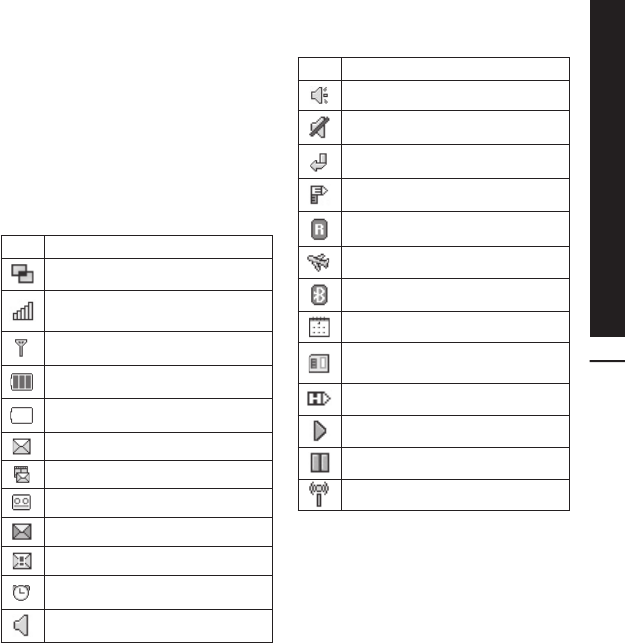
Your standby screen
19
THE STATUS BAR
The status bar uses various icons to
indicate things like signal strength, new
messages and battery life as well as telling
you whether your Bluetooth or GPRS is
active.
Below is a table which explains the
meaning of icons you’re likely to see in the
status bar.
Icon Description
Multitasking
Network signal strength (number
of bars will vary)
No network signal
Remaining battery life
Battery empty
New text message
Multimedia Message
New voice message
Message inbox is full
Message sending failed
An alarm is set
Normal profile in use
Icon Description
Outdoor profile in use
Silent profile in use
Calls are diverted
EDGE in use
Roaming
Flight mode is on
Bluetooth is active
Set the schedule
View the status of external
memory
HSDPA in use
Play the MP3 file
Pause the MP3 file
Wifi on

Your standby screen
20
CHANGING YOUR STATUS FROM
THE STATUS BAR
Touch the current status icon that
represents your current setting in the
status bar to open the Status Summary.
It shows the current Time, Network, SVC
ID, Battery, Handset memory, External
Memory, Profile, MP3, Bluetooth and
Wifi status. You can set Profile type,
play/pause MP3 and activate/deactivate
Bluetooth and Wifi.
USING THE MULTITASKING
FUNCTION
Press side key to open the Multitasking
menu. From here you can view all the
applications you have running and access
them with one touch.
From any application, press the
Multitasking key and select Home screen
to return to the standby screen without
exiting or closing the application.
When you have an application running in
the background (e.g. a game or the FM
radio), will appear in the status bar.
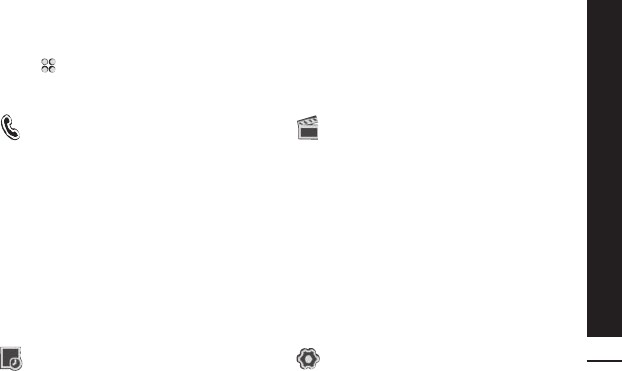
Menu map
21
Touch in the standby screen to open a Top menu. From here you can access further
menus: Communicate, Entertainment, Utilities and Settings.
Communicate
1 Dialling
2 Speed dials
3 Contacts
4 Call history
5 New message
6 New Email
7 Message box
8 Messaging
Utilities
1 Browser
2 World time
3 Organiser
4 Alarms
5 Memo
6 Voice recorder
7 Tools
8 STK (SIM Tool Kit)
Entertainment
1 Gallery
2 My stuff
3 Camera
4 Video camera
5 Muvee studio
6 Music
7 FM radio
8 Games & apps
Settings
1 Profiles
2 Screen settings
3 Phone settings
4 Call settings
5 Touch settings
6 Connectivity
7 Bluetooth
8 Wi-Fi

The basics
22
CALLS
MAKING A CALL OR VIDEO CALL
1. Touch to open the keypad.
2. Key in the number using the keypad. To
delete a digit press the clear key.
3. Touch the hard key to initiate the
call.
4. To end the call press the hard key.
° : Makes a voice call
° : Makes a video call
° : Delete a number or character
° : Exits the dialling keypad
To enter + for making an international
call, touch for two seconds.
Touch the lock/unlock key to lock the
touchscreen to prevent calls being made
by mistake.
You can Make video call, Send message,
Save number or Search contacts by
tapping .
CHANGING THE SETTING OF
DIALLING KEYPAD DISPLAY
1. Touch to open the keypad.
2. Touch and select Dial screen
setting to change the display of
diallinng pad.
3. You can change the font style, size and
colour.
MAKING A CALL FROM YOUR
CONTACTS
1. From the standby screen touch
to open the address book, or touch
Contacts in Communicate tab.
2. You can choose from Add contact,
Search, Groups, and Settings.
3. Choose Search, touch Name and enter
the first few letters of the contact you
would like to call.
4. From the filtered list, touch the contact
you’d like to call and select the number
to use if you have more than one saved.
5. Touch Call.

You can search your contacts from the
call screen. Touch and choose Search
contacts. Scroll through your contacts or
enter the first few digits of a number to
filter the list.
ANSWERING AND REJECTING A
CALL
When your phone rings press the
hard key to answer the call.
Tap to mute the ringing. This is great if
you’ve forgotten to change your profile to
Silent for a meeting.
Press the hard key to reject an
incoming call.
The basics
23
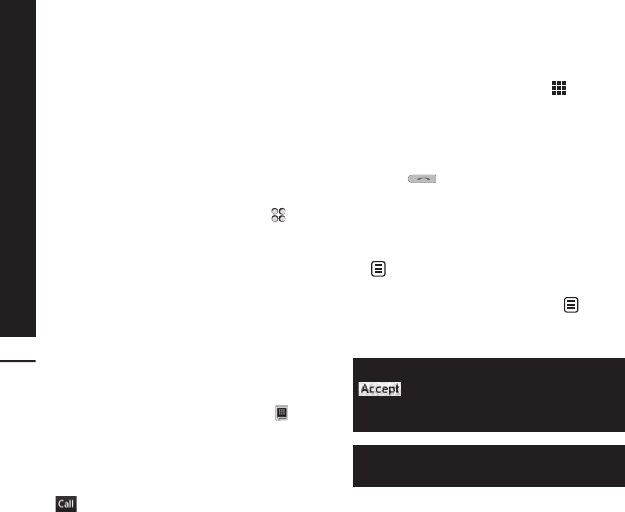
Adjusting the call volume
To adjust the volume during a call, use the
up and down buttons on the left side of
the phone.
Speed dialling
You can assign a frequently-called contact
to a speed dial number.
1. From the standby screen touch to
open the menu.
2. Touch Speed dials.
3. Your Voicemail and Videomail are
already set to speed dial 1. You cannot
change this. Touch any other number to
assign it a speed dial contact.
4. Your address book will open. Select
the contact you’d like to assign to that
number by touching the phone number
once.
To call a speed dial number, touch from
the standby screen then press and hold
the assigned number until the contact
appears on screen. The call will initiate
automatically, there’s no need to press
.
Making a second call
1. During your initial call, touch and
select the number you want to call.
2. Dial the number or search your contacts
(see Making a call or video call on
page 24 for details).
3. Press to connect the call.
4. Both calls will be displayed on the call
screen. Your initial call will be locked
and the caller put on hold.
5. To change between the calls, touch
and choose Swap call or press the
number of the held call.
6. To end one or both calls press and
select End call followed by All calls,
Held call or Active call.
You can combine your calls by selecting
then Join. Check that your
network provider supports conference
calling.
You will be charged for each call you
make.
The basics
24

The basics
25
Turning off DTMF
DTMF allows you to use numerical
commands to navigate menus within
automated calls. DTMF is switched on as
default.
To turn it off during a call (to make a note
of a number for example) touch and
select DTMF off.
Viewing your call logs
To scroll through a list of options, touch
the last item visible and slide your finger
up the screen. The list will move up so
more items are visible.
Touch and select Communicate
and tap Call history.
Choose to view:
° All calls: View a complete list of all your
dialled, received and missed calls.
° Dialled calls: View a list of all the
numbers you have called.
° Received calls: View a list of all the
numbers that have called you.
° Missed calls: View a list of all the calls
you have missed.
From any call log touch and Delete all
to delete all the recorded items.
Touch any single call log entry to view
the date, time and duration of the call.
Using call divert
1. Touch , select Setting and
choose Call settings.
2. Touch Call Divert and choose Video
calls and/or Voice calls.
3. Choose whether to divert all calls, when
the line is busy, when there is no answer
or when you are not reachable.
4. Input the number you’d like to divert to.
5. Touch Request to activate.
Charges are incurred for diverting calls.
Please contact your network provider
for details.
To turn off all call diverts, choose
Deactivate all from the Call divert menu.

The basics
26
Using call barring
1. Touch , select Setting and
choose Call settings.
2. Touch Call barring and choose Video
calls and/or Voice calls.
3. Choose any or all of the six options:
All outgoing
Outgoing international
Outgoing international calls except
home country
All incoming
Incoming when abroad
4. Enter the call barring password. Please
check with your network operator for
this service.
Select Fixed dial number to turn on and
compile a list of numbers which can be
called from your phone. You’ll need your
PIN2 code from your operator. Only
numbers included in the fixed dial list can
be called from your phone.
Changing the common call setting
1. Touch , select Setting and
choose Call settings.
2. Touch Common settings (you may have
to scroll down to see this). From here
you can amend the settings for:
° Call reject: Slide the switch to highlight
the Reject list. You can touch the text box
to choose from all calls, specific contacts
or groups, or those from unregistered
numbers (those not in your contacts).
Touch Save to change the setting.
° Send my number: Choose whether your
number will be displayed when you call
someone.
° Auto redial: Slide the switch left for On
or right for Off.
° Answer mode: Choose whether to
answer the phone using the send key or
any key.
° Minute minder: Slide the switch left to On
to hear a tone every minute during a call.
° BT answer mode: Select Hands-free to
be able to answer a call using a Bluetooth
headset, or select Handset to press a
key on the handset to answer a call.
° Save new number: Select Yes to save a
new number.
° Select line: You can send your phone
number depending on two line service
such as line 1 or line 2.

The basics
27
To scroll through a list of options, touch
the last item visible and slide your finger
up the screen. The list will move up so
more items are visible.
Changing your video call settings
1. Touch , select Setting and
choose Call settings.
2. Touch Video call.
3. Choose the settings for your video
calling. Determine whether to Use
private picture/ My image size and
select one, and/or switch on the Mirror.

The basics
28
CONTACTS
Searching for a contact
There are two ways to search for a
contact:
From the standby screen
1. From the standby screen touch then
to open the address book. To delete a
digit press the Clear hard key.
2. Touch Call or the hard key to
initiate the call.
You can search by group by selecting
Groups. This will bring up a list of all your
groups.
From the main menu
1. Touch , select Communicate.
2. Touch Contacts.
3. Your address book will bring up a list
of the contacts corresponding to the
letters you’ve entered.
To scroll through your list of contacts,
touch the last item visible and slide your
finger up the screen. The list will move
up so more items are visible.
Adding a new contact
1. From the standby screen touch and
select Add contact.
2. Choose whether to save the contact to
your Handset or USIM.
3. Enter the first and last name of your new
contact. You do not have to enter both,
but you must enter one or the other.
4. Enter up to five different numbers and
assign a type for each. Choose from
Mobile, Home, Office, Pager, Fax, VT
and General. Touch OK.
5. Add an email.
6. Assign the contact to one or more
groups. Choose from No group, Family,
Friends, Colleagues, School or VIP.
7. You can also add a Ringtone, Birthday,
Anniversary, Homepage, Home
address, Company name, Job title,
Company address and a Memo.
8. Touch Save to save the contact.
You can create customised groups for
your contacts, see Creating a group on
page 31.

The basics
29
Contact options
There are many things you can do when
viewing a contact. Here’s how to access
and use the options menu:
1. Open the contact you’d like to use. See
Searching for a contact on page 30.
2. You can call or send a message directly
from here.
3. Press to open the list of options.
From here you can:
° Make a video call: Video call the
contact.
° Edit: Change any of the contact’s details.
° Delete: Delete the contact. Touch Yes if
you are sure.
° Copy or Move to USIM/Handset:
Choose to move or copy to the USIM card
or handset (depending on where you
originally saved the contact).
° Send business card: Send the contact’s
details to another person as a business
card. Choose to send as a Text message,
Multimedia message, Email or via
Bluetooth.
Send message - Send a message to
the contact. If the contact has an email
address, select whether you’d like to
send an email or SMS/MMS. See page 35
for details on how to send messages.
Creating a group
1. From the standby screen touch and
select Groups.
2. Touch .
3. Select Add group.
4. Enter a name for your new group.
5. Touch Save.
If you delete a group, the contacts which
were assigned to that group will not be
lost. They will remain in your address
book.
You can edit an existing group by
highlighting it and touching . Choose
to Add members to the group from
your contacts, assign a Group ringtone,
Rename the group or Delete a group.

The basics
30
Changing your contact settings
You can adapt your contact settings so
that your address book suits your own
preferences.
To scroll through a list of options, touch
the last item visible and slide your finger
up the screen. The list will move up so
more items are visible.
1. From the standby screen touch
and select Settings.
2. From here you can adjust the following
settings:
° Contact list settings: Choose whether
to view contacts saved to both your
Handset & USIM, Handset only or USIM
only.
You can also choose to show the first
name or last name of a contact first.
° Synchronise contact: Connect to your
server to synchronise your contacts.
° Copy: Copy your contacts from your
USIM to your handset or from your
handset to your USIM. Choose to do this
one at a time, or all at once. If you select
one at a time, you’ll need to select each
contact to copy one by one.
° Move: This works in the same way as
Copy, but the contact will only be saved
to the location you’ve moved it to. So, if
you move a contact from the USIM to the
handset it will be deleted from the USIM
memory.
° Send all contacts via Bluetooth: Send
all of your contacts to another device
using Bluetooth. You will be prompted
to turn on Bluetooth if you select this
option.
° Backup contacts: See Backing up and
restoring your phone’s information on
page 76.
° Restore contacts: See Backing up and
restoring your phone’s information on
page 76.
° Clear contacts: Delete all your contacts.
Touch Yes if you are sure you want to
wipe your address book.
Viewing information
1. From the standby screen touch touch
and Information.
2. From here you can view your Service
dial numbers, your Own number, your
Memory info. (how much memory
space you’ve got left) and My business
card.
If you’ve yet to add a business card for
yourself, select My business card and
enter all your details as you would for
any contact. Touch Save to finish.

The basics
31
MESSAGING
Messaging
Your GW520 combines SMS, MMS and
email into one intuitive and easy to use
menu.
There are two ways to enter the messaging
centre:
1. Touch from the standby screen.
2. Touch from the standby screen,
then select Communicate then
Messaging.
Sending a message
1. Touch New message in Communicate
tab to open a blank message or select
Create new message in Messaging
menu.
2. From here you can send a text
message or Multimedia message. To
send an email, choose New Email in
Communicate tab.
3. Touch Insert, to add an image, video,
sound or template.
4. Touch To1 at the top of the screen to
enter the recipient’s number, or touch
the search icon to open your address
book. Touch Send. Enter the phone
number or touch Contacts to open
your contacts list. You can add multiple
contacts.
You will be charged per 160 character
text message for each person that you
send the message to.
If an image, video or sound is added to
an SMS it will be automatically converted
to an MMS and you will be charged
accordingly.
Quick reply - Send a reply promptly to
the selected message using a template.
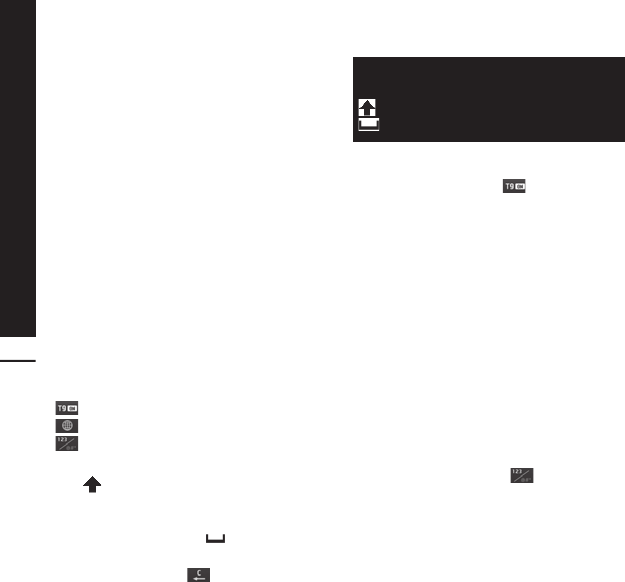
The basics
32
Entering text
There are three ways to enter text:
T9 text mode/ Normal text mode/Qwerty
keypad.
Tap the screen once, the keyboard
appears.
Touch to turn on T9 predictive text.
You can choose the writing language.
Tap to change numbers, symbols and
texts keypad.
Use to scroll through the different
keyboard types in each text entry mode
(for example, capitals or lower case).
To enter a space touch .
To delete character or remove the
sentece, touch clear .
Simply touch each letter to write your
message and press:
to switch to upper case
to add a space
T9 predictive
In T9 mode you will see .
T9 mode uses a built-in dictionary to
recognise words you’re writing based
on the key sequences you touch. Simply
touch the number key associated with the
letter you want to enter, and the dictionary
will predict the word you want to use.
For example, press 8, 3, 5, 3, 7, 4, 6, 6, 3 to
write ‘telephone’.
If the word you want doesn’t appear, touch
Spell. If you touch Spell you can then
enter the word using Abc manual mode
and your word or name will be added to
the dictionary.
Abc manual
In Abc mode you will see .
In Abc mode you must touch the key
repeatedly to enter a letter. For example,
to write ‘hello’, touch 4 twice, 3 twice, 5
three times, 5 three times again, then 6
three times.

The basics
33
QWERTY KEYPAD
Entering text
You can enter alphanumeric characters
using the phone’s keypad. For example,
storing names in Contacts, writing a
message and creating scheduling events in
the calendar all require entering text. The
following text input methods are available
in the phone: ABC manual mode and 123
mode.
Some fields may allow only one text
input mode (e.g. telephone number in
address book fi elds).
To input a symbol in the text entry field,
press the key and select a symbol, then
select OK.
Scroll using the navigation keys to show
more symbol options.
Complete each word with a space by
pressing .
To delete a character, press key.
Text input mode using the keypad
When you are required to enter text, for
example when writing a message, the
keypad will default to ABC mode. If you
are entering a number, for example when
making a call, the keypad number keys will
default to numbers.
In ABC mode you can enter numbers by
first pressing and then the number you
require.
Sending an email using your new
account
To send/receive an email, you should set
up an email account (see below).
1. Touch from the standby screen, and
select Messaging.
2. Choose Create new message- Email and
a new email will open. Or, if you select
New Email in Communicate tab, you
can enter this menu directly.
3. You can enter the recipient’s address
and write your message. You can also
attach images, videos, sounds or other
file types.
4. Enter your message using the keypad.
5. Select Options and choose an
attachment to add: Image/Video/
Sound/Template/Emoticon/Bcc/
Singture/Name&Number/More
(Business card/Schedule/Memo/To
do /My business card/FlashContents/
Documents/Other files).

The basics
34
Setting up your email
You can stay in touch on the move using
email on your GW520. It’s quick and simple
to set up a POP3 or IMAP4 email account.
If you complete sett up e-mail account,
“Update inbox now?” message will be
displayed. You can receive the e-mail of
selected account.
To scroll through a list of options, touch
the last item visible and slide your finger
up the screen. The list will move up so
more items are visible.
1. Touch from the standby screen, and
touch Messaging.
2. Select Settings.
3. Touch Mailbox then Email accounts.
4. Touch Add account.
5. You can now choose how your account
works:
° Email address: Enter the e-mail address.
° Password: Enter the account’s password.
° Username: Enter the account’s
username.
° Mailbox type: Enter the mailbox type,
POP3 or IMAP4.
° Incoming server: Enter the incoming
email server address
° Outgoing server: Enter the outgoing
email server address
° SMTP authentication: Choose the
security settings for the outgoing mail
server
° Account name
Now your account is set up, it will appear
in the list of accounts in your Email folder.
Retrieving your email
You can automatically or manually
check your account for new emails. See
Changing your email settings on page 37
to check automatically.
To check manually:
1. Touch then Messaging.
2. Select Mailbox.
3. Touch the account you want to use then
.
4. Choose Retrieve or Sync and your
GW520 will connect to your email
account and retrieve your new
messages.

The basics
35
Changing your email settings
You can change your email settings
according to your own preferences.
To scroll through a list of options, touch
the last item visible and slide your finger
up the screen. The list will move up so
more items are visible.
1. Touch from the standby screen, and
touch Messaging.
2. Select Settings.
3. Touch Email and then you can adapt the
following settings:
° Email accounts: Set up the Email
account.
° Allow reply Email: Choose to allow the
sending of read confirmation messages.
° Request reply Email: Choose whether to
request read confirmation messages.
° Retrieve interval: Choose how often
your GW520 checks for new email
messages.
° Retrieve amount: Choose the number of
emails to be retrieved at one time.
° Include message in Fwd & Reply:
Choose to include the original message
in your reply.
° Include attachment: Choose to include
the original attachment in any reply.
° Auto Retrieval in Roaming: Choose
whether to retrieve your messages
automatically when abroad (roaming).
° New email notification: Choose whether
to be alerted to new emails.
° Signature: Create an email signature
and switch this feature on.
° Priority: Choose the priority level of your
email messages.
Message folders
You’ll recognise the folder structure
used on your GW520, which is fairly self-
explanatory.
° Inbox: All the messsages you receive are
placed into your inbox From here you can
view, delete and more, see Managing
your messages below for details. You
can enter this menu through Message
box.
° Mailbox: All the emails you receive
on your GW520 will be placed in your
mailbox.
° Drafts: If you don’t have time to finish
writing a message, you can save what
you’ve done so far here.
° Outbox: This is a temporary storage
folder while messages are being sent.
° Sent items: All the messages you have
sent are placed in this folder.
° My Folders: Create folders to store your
messages.
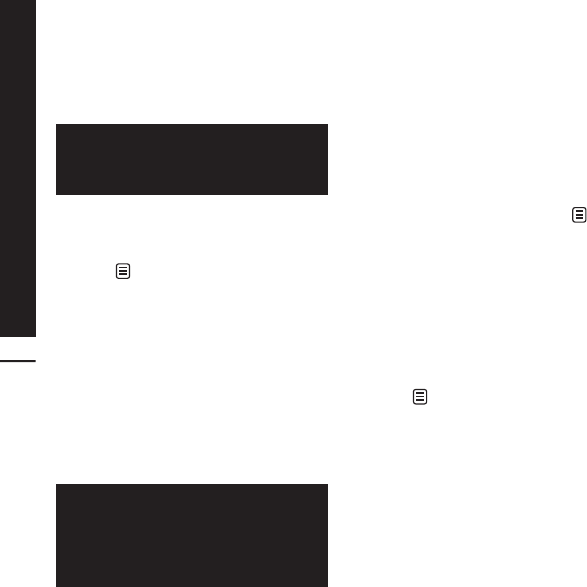
The basics
36
Managing your messages
You can use your Inbox to manage your
messages.
To scroll through a list of options, touch
the last item visible and slide your finger
up the screen. The list will move up so
more items are visible.
1. Touch Messaging then Inbox. Or, you
can enter this menu through Message
box in Communicate tab.
2. Touch and then choose to:
° Delete: Delete marked messages.
° Change view: You can change the style
of message display.
° Create new message: Open a new blank
message or email.
° Move to my folders: Move the marked
messages to My folders.
° Filter: View your message by type. This
will group only text message separately
from MMS.
° Delete all: Delete all of the messages.
If you see the message No space for
USIM messages you should delete some
messages from your inbox.
If you see the message No space
for messages you can delete either
messages or saved files to create space.
Using templates
Create templates for the SMS and MMS
messages you send most frequently. You’ll
find some templates already on your
phone, you can edit these if you wish.
1. Touch Messaging then choose
Templates.
2. Choose Text templates or Multimedia
templates. You can then touch
to Add new, Delete or Delete all
templates.
Using emoticons
Liven up your messages using emoticons.
You’ll find some commonly used emoticons
already on your phone.
1. Touch Messaging then choose
Emoticons.
2. Touch to Add new, Delete or Delete
all emoticons.

The basics
37
Changing your text message
settings
Your GW520 message settings are pre-
defined so that you can send messages
immediately. These settings can be
changed according to your preferences.
To scroll through a list of options, touch
the last item visible and slide your finger
up the screen. The list will move up so
more items are visible.
Touch Messaging then choose Settings
and Text message. You can make changes
to:
° Text message centre: Enter the details
of your message centre.
° Delivery report: Slide the switch to the
left to receive confirmation that your
messages have been delivered.
° Validity period: Choose how long your
messages are stored at the message
centre.
° Message types: Convert your text into
Voice, Fax, X.400 or Email.
° Character encoding: Choose how your
characters are encoded. This impacts the
size of your messages and therefore data
charges.
° Send long text as: Choose to send long
messages as Multiple SMS or as MMS.
Changing your multimedia
message settings
Your GW520 message settings are pre-
defined so that you can send messages
immediately. These settings can be
changed according to your preferences.
Touch Messaging then choose Message
settings and Multimedia message. You
can make changes to:
° Retrieval mode: Choose Home or
Roaming network. If you then choose
Manual you will receive only notifications
of MMS and you can then decide whether
to download them in full.
° Delivery report: Choose to allow and/or
request a delivery report.
° Read reply: Choose to allow and/or send
a read reply.
° Priority: Choose the priority level of your
MMS.
° Validity period: Choose how long your
message is stored at the message centre.
° Slide duration: Choose how long your
slides appear on screen.
° Creation mode: Choose your message
creation mode.
° Delivery time: Choose how long before a
message is delivered.
° Multi msg. centre: Enter the details of
your message centre.

The basics
38
Changing your other settings
Touch Messaging , choose Settings then:
° Voicemail: Touch to add a new
Voicemail service. Contact your network
operator for more information on the
service they provide.
° Service message: Choose to receive
or block service messages. You can also
set your message security by creating
trusted and untrusted lists of senders.
° Info service: Choose your reception
status, language and other settings.
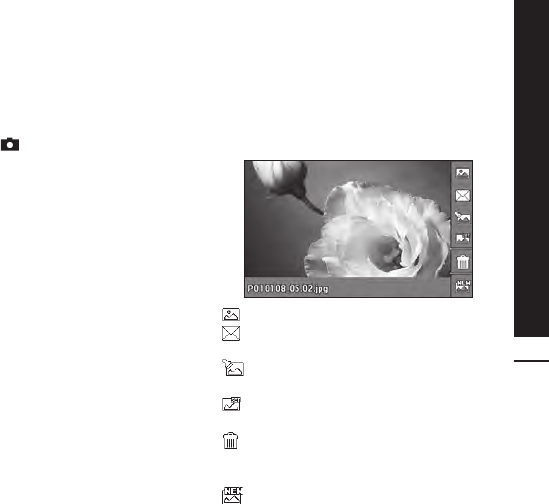
Get creative
39
CAMERA
Taking a quick photo
1. Press the key on the right side of the
phone.
2. The viewfinder will appear on screen.
3. Holding the phone horizontally, point
the lens towards the subject of the
photo.
4. Slightly press the capture button, a
focus box will appear in the centre of
the viewfinder screen.
5. Position the phone so you can see the
subject of your photo in the focus box.
6. When the focus box turns green and the
tone sounds the camera has focused on
your subject.
7. Press the capture button fully.
After you've taken your photo
Your captured photo will appear on screen.
The name of the image runs along the
bottom of the screen together with five
icons down the right side.
Go to gallery of pictures directly.
Touch to send the photo as a
message, e-mail or Bluetooth.
Touch to edit the image by using
various tools.
Touch to set the picture you have
taken as Wallpaper.
Touch to delete the photo you have
just taken and confirm by touching Yes.
The viewfinder will reappear.
Touch to take another photo
straightaway. Your current photo will be
saved.
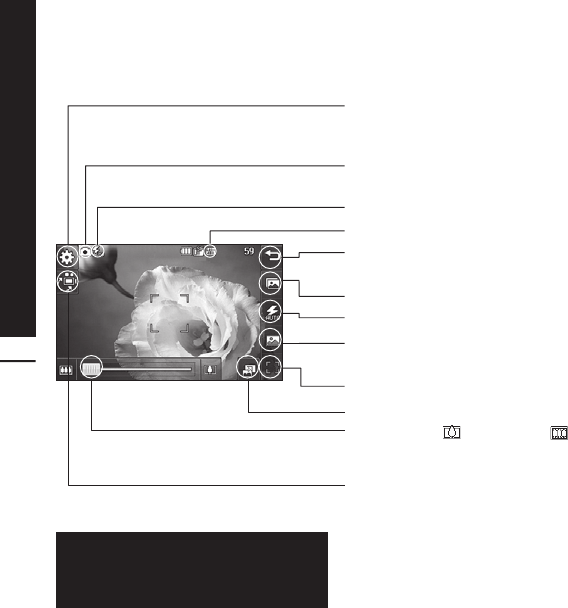
Get creative
40
Getting to know the viewfinder
Settings - Touch this icon to open the
settings menu. See Using the advanced
settings on page 49 for details.
Camera mode - Camera mode is
selected.
Flash status
Size
Back - Touch here to return to the
standby screen.
Gallery
Flash - See Using the flash on page 43.
Shot type - See Choosing a shot type on
page 43.
Shutter - Take the picture
View mode - Full screen/ Full image
Zoom - Touch to zoom in or to
zoom out. Alternatively you can use the
side volume keys.
Video camera mode - Convert from
camera to video camera mode.
The shortcut options disappear after a
few seconds automatically. Simply touch
the centre of the viewfinder once. To
recall the options touch the screen again.

Get creative
41
Using the flash
The flash is set to auto as default, but
there are other options.
1. Select from the right side of the
viewfinder to enter the flash sub-menu.
2. There are three flash options:
° Auto: Your camera will assess the lighting
needed to take a good picture and use
the flash as necessary.
° Always on: The flash will always be on.
° Always off: The camera will never flash.
This is useful if you want to save battery
power.
° When taking: The camera will flash when
taking a picture.
3. Touch the flash option you’d like to use.
4. When you’ve made your selection the
flash menu will automatically close,
ready for you to take your picture.
5. The flash status icon in the viewfinder
will change according to your new flash
mode.
Choosing a shot type
1. Touch to open the available shot
types.
2. Choose from three options:
° Normal shot: This is the default shot
type, the photo will be taken in the
normal way, as outlined in taking a quick
photo.
° Burst shot: This enables you to take
nine shots automatically in very quick
succession.
° Panorama: This shot type is great for
taking a photo of a large group of people
or for capturing a panoramic view.

Get creative
42
Taking a burst shot
1. Touch open the available shot types
and select Burst shot then choose the
number of shots.
2. Position the subject in the viewfinder
and press the capture button as you
would to take a normal photo.
3. You can save one of the shots. Select
the one you want to keep by touching
the thumbnail: once to view and touch
Save to save.
Taking a panoramic shot
Capture life as it appears using a
panoramic shot. The camera will let you
take three photos, all aligned, and combine
them into one wide angle image.
1. Touch to open the available shot
types and select Panorama shot.
2. Take the first photo as normal. A
ghosted version of the right side of the
image will appear in the viewfinder.
3. When you take the second and third
photo, line the ghost of the previous
image up with the image in the
viewfinder.
4. In the photo gallery, the photos will be
saved as panoramic image.
Due to the image size the panoramic
photo will appear slightly distorted in
the Gallery view. Touch it twice to view
it properly.
Adjusting the exposure
Exposure defines the difference between
light and dark in an image. A low contrast
image will appear foggy, whereas a high
contrast image will appear much sharper.
1. From the viewfinder touch to open all
the advanced settings options.
2. Touch Exposure.
3. Slide the contrast indicator along the
bar, towards for a lower exposure,
hazier image or towards for a higher
exposure, sharper image.

Get creative
43
Using the advanced settings
From the viewfinder touch to open all
the advanced settings options.
Preview settings
° Exposure: Exposure value refers to the
amount of light for a given exposure.
When the main subject is darker than the
background, increase exposure value.
If the subject is much lighter than the
background, decrease exposure value.
° Size: Change the size of the photo to
save on memory space or take a picture
preset to the correct size for contact.
See Changing the image size on page
46.
° Colour Effect: Choose a colour tone to
apply to the photo you’re taking. See
Choosing a colour effect on page 46.
° White balance: Choose from Auto,
Incandescent, Sunny, Flourescent or
Cloudy.
° Macro: Switch on to take close up shots.
° Self-timer: The self-timer allows you
to set a delay after the capture button
is pressed. Choose from 3 seconds, 5
seconds or 10 seconds. Great for that
group photo you want to be part of.
° ISO: ISO determines the sensitivity of the
camera’s light sensor. The higher the ISO,
the more sensitive the camera will be.
This is useful in darker conditions when
the flash can’t be used. Choose an ISO
value from Auto, ISO 100, ISO 200, ISO
400 or ISO 800.
° Quality: Choose between Super fine,
Fine and Normal. The finer the quality
the sharper a photo will be, but the file
size will increase as a result, which means
you’ll be able to store fewer photos in
your memory.
° Inner/Outer Camera: For self portraits,
switch to the LG GW520’s inner camera.
Other settings
° Memory: Choose whether to save your
photos to the Handset memory or to the
External memory.
° Image stabilization: Enables you to
take a photo without camera instability
or shake.
° Focus: Choose from On or Off.
° Shutter sound: Select one of the three
shutter sounds.
° Grid screen: Choose from Off, Simple
cross or Trisection
° Reset settings: Reset all the camera
settings.
When you exit the camera all your
settings will return to default, except
image size and image quality. Any non-
default settings you require will need to
be reset, for example colour tone and
ISO. Check them before you shoot your
next photo.

The settings menu is super imposed over
the viewfinder, so when you change
elements of the image colour or quality
you’ll be able to see the image change in
preview behind the settings menu.
Changing the image size
The more pixels, the larger the file size,
which in turn means they take up more
of your memory. If you want to fit more
pictures on to your phone you can alter
the pixel number to make the file size
smaller.
1. From the viewfinder touch in the top
left corner.
2. Select Size from the Preview menu.
3. Select a pixel value from the six
numerical options (5M: 2592x1944,
3M: 2048x1536, 2M: 1600x1200, 1M:
1280x960, 640x480, 320x240) or
choose the preset:
Choosing a colour effect
1. From the viewfinder touch in the top
left corner.
2. Select Colour Effect from the Preview
menu.
3. There are five colour tone options: Off,
Black & White, Negative or Sepia.
4. When you’ve made your selection the
colour tone menu will be closed after
selcting back icon, ready for you to take
your picture.
You can change a photo taken in colour
to black and white or sepia after it’s
taken, but you cannot change a picture
taken in black and white or sepia back
to colour.
Get creative
44
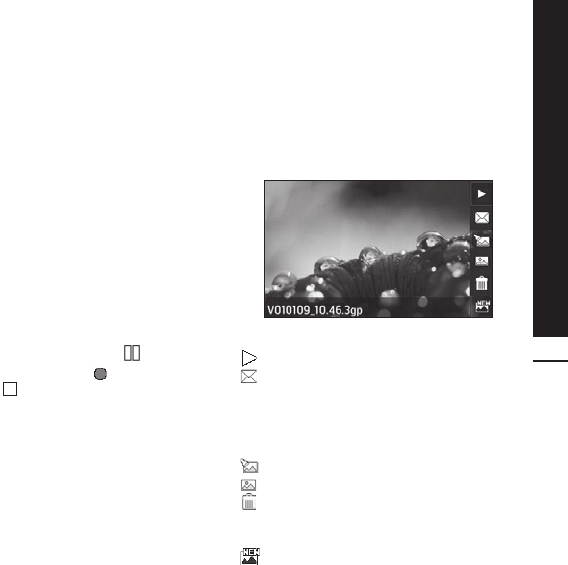
Get creative
45
VIDEO CAMERA
Shooting a quick video
1. Touch Video camera in Entertainment
tab.
2. The video camera’s viewfinder will
appear on screen.
3. Holding the phone horizontally, point
the lens towards the subject of the
video.
4. Press the capture button once to start
recording.
5. REC will appear at the top of the
viewfinder and a timer at the bottom
showing the length of your video.
6. To pause the video touch and
resume by selecting .
7. Touch on screen or press the capture
button a second time to stop recording.
After you've shot your video
A still image representing your captured
video will appear on screen. The name of
the video runs along the bottom of the
screen together with five icons down the
right side .
Touch to play the video.
Touch to send the video as Message,
Email or by Bluetooth. See page 33 for
Sending a message, or page 85 for
Sending and receiving your files using
Bluetooth.
Touch to edit video file.
Touch to view a gallery of saved videos.
Touch to delete the video you have just
made and confirm by touching Yes. The
viewfinder will reappear.
Touch to shoot another video straight
away. Your current video will be saved.
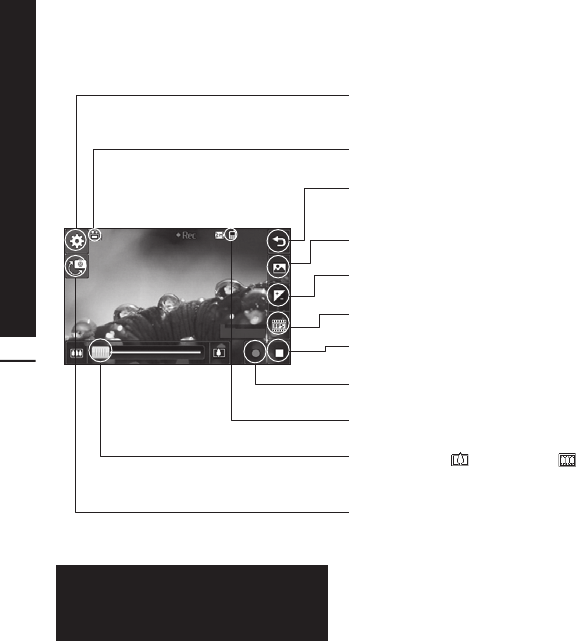
Get creative
46
Getting to know the viewfinder
Settings - Touch this icon to open
the settings menu. See Adjusting the
exposure on page 49 for details.
Video mode - Video mode is selected.
Back - Touch here to return to the
standby screen.
Gallery
Brightness - See Adjusting the Exposure
on page 49.
Recording speed
Recording stop
Recording start
Saving to handset memory/external
memory
Zoom - Touch to zoom in or to
zoom out. Alternatively you can use the
side volume keys.
Camera mode - Change from video
camera to camera mode.
The shortcut options disappear after a
few seconds automatically. Simply touch
the centre of the viewfinder once. To
recall the options touch the screen again.

Get creative
47
Adjusting the Exposure
Exposure defines the difference between
light and dark in an image. A low contrast
image will appear foggy, whereas a high
contrast image will appear much sharper.
1. Touch .
2. Slide the exposure indicator along the
bar, towards for a lower exposure,
hazier image, or towards for a higher
contrast, sharper image.
Using the advanced settings
From the viewfinder touch Settings to
open all the advanced settings options.
Preview settings
° Video size: Change the size of the video
to save on memory space. See Changing
the video image size on page 50.
° Colour Effect: Choose a colour tone to
apply to the video you’re taking. See
Choosing a colour tone on page 50.
° White balance: The white balance
ensures that any white in your videos
is realistic. In order for your camera
to correctly adjust the white balance
you may need to determine the
light conditions. Choose from Auto,
Incandescent, Sunny, Fluorescent or
Cloudy.
° Quailty: Choose between Super fine,
Fine and Normal. The finer the quality
the sharper a video will be, but the file
size will increase as a result, which means
you’ll be able to store fewer videos in the
phone’s memory.
° Set time: Set a duration limit for your
video. Choose from No limit, or MMS to
limit the size to be able to send the video
as an MMS.
If you choose MMS duration, try choosing
a lower image quality to enable you to
shoot a longer video.
° Inner camera: Switch to your GW520’s
inner camera to record a video of
yourself.
Other settings
° Memory: Choose whether to save your
videos to the Handset memory or to the
External memory.
° Voice: Choose Mute to record a video
without sound.
° Reset settings: Reset all the video
camera settings.

Changing the video image size
The more pixels, the larger the file size,
which in turn means they take up more
memory. If you want to fit more videos
onto your phone you can alter the pixel
number to make the file size smaller.
1. From the viewfinder touch Settings in
the top left corner.
2. Select Video size from the Preview
menu.
3. Select a pixel value from the five
options:
720x480(D1), 640x480(VGA) - The
highest quality widescreen option.
400X240 (Wide) - This is also
widescreen, but of a lower resolution.
640x480 (VGA) - Standard sized VGA.
320x240 (QVGA) - Smaller image size,
therefore smaller file size. Great for
saving on memory space.
176x144 (QCIF) - Smallest image size
and therefore smallest file size.
4. Select the size option you’d like to use.
For video format conversion software,
see the CD you received with your
GW520.
Choosing a colour tone
1. From the viewfinder touch in the top
left corner.
2. Select Colour Effect from the settings
menu.
3. There are five colour tone options, Off,
Black & White, Negative, Sepia.
4. Touch the colour tone you’d like to use.
You can change a video shot in colour to
black and white or sepia after it’s taken,
but you cannot change a video shot in
black and white or sepia back to colour.
You can still alter the image size, video
quality, duration, mute, white balance,
colour tone and the memory by touching
Settings in the same way as when using
the main camera.
Get creative
48

YOUR PHOTOS AND VIDEOS
Viewing your photos and videos
1. Touch on your camera preview
screen.
2. Your gallery will appear on screen.
3. Touch the video or photo twice to open
it fully.
4. Videos will begin to play automatically.
To pause playback touch the screen to
bring up the options and select .
Flick left or right to view other photos
or videos.
To delete a photo or video, open it and
select . Touch Yes to confirm.
Using zoom when viewing a photo
Use the fingers diagonally on the image to
zoom in or zoom out.
Adjusting the volume when viewing
a video
To adjust the volume of the audio on a
video whilst it is playing, slide the marker
up and down the volume bar on the left
side of the screen.
Viewing your photos as a slide
show
Slideshow mode will show all the photos in
your gallery one at a time as a slideshow.
Videos can not be viewed as a slideshow.
1. Touch the photo you would like to begin
the slideshow twice to open it.
2. Select .
3. The slideshow will begin.
There are options within slideshows:
Touch again to resume playback.
Touch to pause the slideshow on a
particular photo.
Random On/ Off
Touch to increase or decrease the
speed of the slideshow.
Setting a photo as wallpaper
1. Touch the photo you would like to set as
wallpaper twice to open it.
2. Touch .
3. The screen will switch to portrait mode.
You can change the size of the picture.
4. When you are happy with the picture
touch Set.
Get creative
49
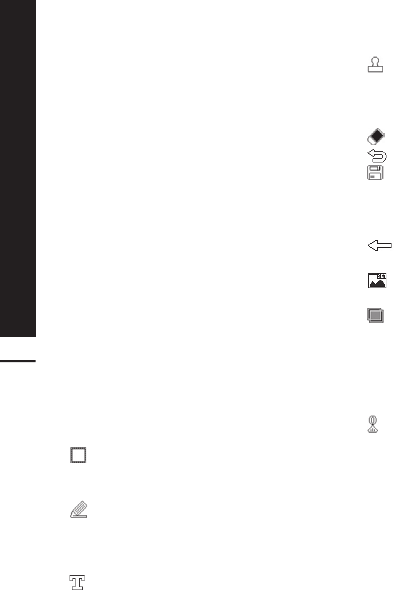
Get creative
50
Editing your photos
There are loads of great things you can
do to your photos to change them, add to
them or liven them up a little.
1. Open the photo you’d like to edit and
touch Edit to bring up the options.
2. Touch the icons to adapt your photo:
Crop your photo. Choose a square or
circular crop area and move your finger
across the screen to select the area.
Draw something on your photo
freehand. Select the thickness of the line
from the four options and the colour you
would like use.
Put writing on the picture. See
Adding text to a photo on page 53.
Decorate your photo with stamps.
Choose from the different stamps
available and touch your photo
wherever you’d like them to be.
Remove the drawing line.
Touch to return to the gallery.
Save the changes you have made to
the photos. Select to save the changes
over the Original file, or as a New file.
If you select New file enter a file name.
Undo the last Effect or edit you
made to the photo.
Add an effect to a photo by using
various tools.
Touch to open further effect options
including Rotate. There are also more
advanced editing options. See Morphing
a photo, Adding a colour accent and
Swapping the colours in a photo on
page 55.
See Adding an effect to a photo on
page 53.

Get creative
51
Adding text to a photo
1. From the editing screen, touch .
2. Select Signature to add unframed text
or choose one of the speech bubble
shapes then touch OK.
3. Enter your text using the keypad and
touch Done.
4. Move the text bubble by touching it and
sliding it to the place you’d like it to be.
Adding an effect to a photo
1. From the editing screen, touch .
2. Choose to apply any of the eighteen
options to the photo. Select OK icon to
apply the changes or choose to
cancel.
° Face Beautify: Automatically detect a
face in the image and brighten it up.
° Tunnel effect: Change the effect so that
the picture appears to have been taken
in a tunnel.
° Colour negative: Colour negative effect.
° Black and white: Black and white colour
effect.
° Sepia: Sepia effect.
° Blur: Apply a blurred effect.
° Sharpen: Move the marker along the bar
to sharpen the focus of the photo.
° Mosaic blur: Touch to apply a blurred
mosaic effect to the photo.
° Oil painting: Oil painting effect.
° Sketch: Apply an effect to make the
picture look like a sketch.
° Emboss: Emboss effect.
° Solarize: Change the effect of exposure
to the light
° Vivid: An effect of clearness and
brilliance.
° Moonlight: Change the light to look like
moonlight.
° Antique: An old image effect.
° Glow: A light beam effect.
° Cartoon: A cartoon effect.
° Water color: Adjust water color painting.
3. To undo an effect simply touch Undo.
You can add more than one effect to a
photo.
Resizing a photo
1. From the editing screen touch .
2. Choose Resize.
3. Touch your desired size to change the
size of the photo.

Get creative
52
Morphing a photo
Morphing a photo is great for changing
the facial expressions of friends, or just for
distorting a photo for artistic effect.
1. From the editing screen touch .
2. Choose Morphing and four crosses will
appear on the photo.
3. Move the crosses around the photo so
they are on the part you’d like to morph.
For example, if you are morphing a face,
place a cross on the outside corner of
each eye and one each side of the lips.
4. Select a face to represent how you’d
like to morph the photo.
5. Select Save to save the changes.
Adding a colour accent to a photo
1. From the editing screen, touch .
2. Choose Colour accent.
3. Select part of the photo. A traced line
will appear around everything in that
area which is of the same or similar
colour.
For example, someone’s hair or the
colour of their jumper.
4. Touch Done.
5. All colour will be removed from the
photo, apart from the section marked
for colour accenting.
6. Alter the intensity of the accenting
by sliding the marker up or down the
intensity bar.
7. Select Save to save the changes.

Get creative
53
Swapping the colours in a photo
1. From the editing screen, touch .
2. Choose Colour swapping.
3. Select part of the photo. A traced line
will appear around everything in that
area which is of the same or similar
colour.
For example, someone’s hair or the
colour of their jumper.
4. Touch and select a colour.
5. Press OK.
6. The part of the photo selected for
colour accenting will change to the
selected colour.
7. Select Save to save the changes.
Watching your videos on your TV
Connect your GW520 to your TV using the
TV output cable. Open the video you’d like
to watch on TV, press and select .
The TV output cable is available for
purchase separately.
All formats except 320x240 and 176x144
are compatible with watching on TV.
Editing your videos
The editing features are available for
all video types except 640X384 and
640x480.
Don’t record in these formats if you plan to
edit your video.
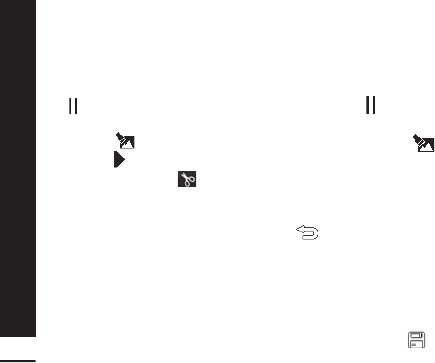
Get creative
54
Trimming the length of your video
1. Open the video you’d like to edit, select
and touch the screen to bring up the
options.
2. Select and choose Trim.
3. Touch and mark the new start and
end points using .
4. Touch Preview to ensure you are happy
with the new cut.
5. Touch Save or, alternatively, touch
to return to the gallery and discard the
changes.
Merging two videos together
1. Open the video you’d like to edit, select
and touch the screen to bring up the
options.
2. Select and choose Video merge.
3. The My videos folder will open. Choose
the video you would like to merge and
touch Select.
4. Touch and slide the photo to merge it to
the end or the beginning of the video.
5. Touch Effect to choose how the videos
merge together: None, Fade out, Pan
zoom, Oval, Uncover, Blind, Checker
board, Dissolve, Split or Shape
diamond.
6. Press followed by Yes to save the
new merged video. Choose to save over
the original file or as a new file.
7. Repeat these steps to merge more
videos.

Get creative
55
Merging a photo with a video
1. Open the video you’d like to edit, select
and touch the screen to bring up the
options.
2. Select and choose Image merge.
3. The My images folder will open. Choose
the photo you would like to merge into
your video and touch Select.
4. Touch and slide the photo to merge it to
the end or the beginning of the video.
5. Touch Effect to choose how the photo
and video merge together: None, Fade
out, Pan zoom, Oval, Uncover, Blind,
Checker board, Dissolve, Split or
Shape diamond.
6. Press followed by Yes. Choose to
save over the original file or as a new
file.
7. Repeat these steps to merge more
photos.
Adding text to a video
1. Open the video you’d like to edit, select
and touch the screen to bring up the
options.
2. Select and choose Text overlay.
3. Enter your text using the keypad and
select Save.
4. Touch and mark when you’d like the
text to appear using .
5. Touch the area of the screen you’d like
the text to appear in.
6. Touch to mark when you’d like the
text to disappear.
7. Touch Preview to ensure you are happy
with the text overlay.
8. Touch Save followed by Yes. Choose
to save over the original file or as a
new file.
9. Repeat these steps to add more text.
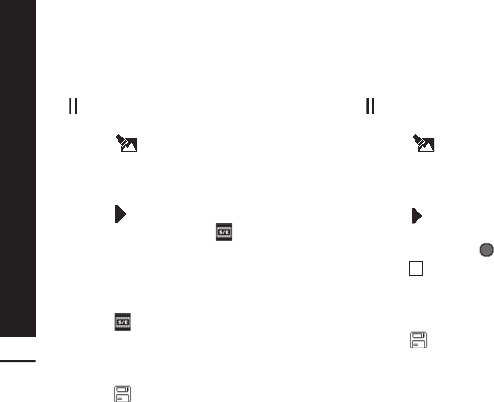
Overlaying a photo
1. Open the video you’d like to edit, select
and touch the screen to bring up the
options.
2. Select and choose Image overlay.
3. The My images folder will open. Choose
the photo you would like to overlay your
video and touch Select.
4. Touch and mark when you’d like the
photo to appear using .
5. Touch the area of the screen you’d like
the photo to appear in. If the photo is
too big it will overlay the whole screen,
not just the area selected.
6. Touch to mark when you’d like the
photo to disappear.
7. Touch Preview to ensure you are happy
with the photo overlay.
8. Touch followed by Yes. Choose to
save over the original file or as a new
file.
9. Repeat these steps to add more photos.
Adding a voice recording
1. Open the video you’d like to edit, select
and touch the screen to bring up the
options.
2. Select and choose Voice recording.
3. The quality of the original audio will be
affected by adding a voice recording.
Touch Yes to continue.
4. Touch to view your video. When you
get to the part you’d like to record your
voice over, press .
5. Press to stop recording and
playback.
6. Touch Preview to ensure you are happy
with the voice recording.
7. Touch followed by Yes to save.
Choose to save over the original file or
as a new file.
8. Repeat these steps to add more voice
recordings to the video.
Get creative
56

Adding a soundtrack to your video
1. Open the video you’d like to edit, select
and touch the screen to bring up the
options.
2. Select and choose Audio dubbing.
3. The My sounds folder will open. Choose
the track you would like to add to your
video and touch Select.
4. The original audio of your video will be
erased. Touch Yes to continue.
5. If the audio is shorter than the video
choose whether to play Once or to
Repeat it.
6. Choose to save over the original file or
as a new file.
Changing the speed of your video
1. Open the video you’d like to edit, select
and touch the screen to bring up the
options.
2. Select and choose Time scaling.
3. Select one of the four speed options: x4,
x2, x1/4, x1/2.
4. Choose to save over the original file or
as a new file.
Adding a dimming effect
1. Open the video you’d like to edit, select
and touch the screen to bring up the
options.
2. Select and choose Dimming effect.
3. Choose to save over the original file or
as a new file.
4. Your video will now fade in at the start
and fade out at the end.
Get creative
57

Get creative
58
MULTIMEDIA
You can store any multimedia files into
your phone’s memory so that you have
easy access to all of your pictures, sounds,
videos and games. You can also save your
files to a memory card. The advantage of
using a memory card is that you can free
up space on your phone’s memory.
To access the Multimedia menu, touch
then Entertainment. Touch My stuff
to open a list of folders storing all of your
multimedia files.
Pictures
My images contains a list of pictures
including default images pre-loaded onto
your phone, images downloaded by you
and images taken on your phone’s camera.
My images option menus
The options which are available to you in
My images depend on what type of image
you have selected. All of the options will
be available for pictures you have taken
on the phone’s camera, but only the Use
as, Print, Sort by and Memory manager
options are available for default images.
When looking at a picture, turn the
phone to landscape to bring up further
options on the right side of the screen.
Choose from send, slideshow, gallery,
edit and delete.
° Send: Send the image to a friend.
° Move: Move an image from the phone
memory to a memory card or vice versa.
° Copy: Copy an image from the phone
memory to a memory card or vice versa.
° Delete: Delete an image.
° Rename: Rename an image.
° Print: Print the selected image using a
printer supported by Bluetooth.
° Create new folder: Create a new folder
within the My images folder.
° Slide show: Create slide show of
selected images.
° Grid view/ List view: Grid view to List
view or vice versa.
° Folder info.: View the information of
each folder.
° Memory manager: View the memory
status.
° Delete all: Delete all of your images.

Get creative
59
Sending a photo
1. Touch then Entertainment.
2. Touch My stuff then choose My images.
3. Touch Send and choose from
Multimedia message, Email or
Bluetooth.
4. If you choose Message or Email, your
photo will be attached to a message and
you can write and send the message as
normal. If you choose Bluetooth, you
will be prompted to turn Bluetooth on
and your phone will search for a device
to send the picture to.
Using an image
You can choose images to use as
wallpapers and screensavers or even to
identify a caller.
1. Touch then Entertainment.
2. Touch My stuff then My images.
3. Select an image and touch .
4. Touch Use as and choose from:
° Wallpaper: Set a wallpaper for the
standby screen.
° Contacts image: Allocate an image to
a particular person in your contacts list
so that the picture shows when they call
you.
° Incoming call: Set an image to appear
during incoming call.
° Outgoing call: Set an image to appear
during outgoing calls.

Get creative
60
Marking up your images
A low- light photo can be adjusted without
lowering the quality of the picture.
1. Touch then Entertainment.
2. Touch My stuff then My images.
Printing an image
1. Touch then Entertainment.
2. Touch My stuff then My images.
3. Select an image and touch .
4. Touch Print then choose between
Bluetooth and PictBridge.
You can to print via bluetooth or by
connecting to a PictBridge compatible
printer.
Moving or copying an image
You can move or copy an image between
the phone memory and the memory card.
You might want to do this to either free up
some space in one of the memory banks or
to safeguard your images from being lost.
1. Touch then Entertainment.
2. Touch My stuff then My images.
3. Select an image and touch .
4. Select Move or Copy.
Creating a slide show
If you want to look at all of the images on
your phone, you can create a slide show
to save you from having to open and close
each individual image.
1. Touch then Entertainment.
2. Touch My stuff then My images.
3. Touch then Slide show.
Checking your memory status
You can check to see how much of your
memory space you have used and how
much you have left to use.
1. Touch then Entertainment.
2. Touch My stuff then My images.
3. Touch then Memory manager.
4. Choose Handset memory or External
memory.
If you do not have a memory card
inserted, you will not be able to select
External memory.

Get creative
61
Sounds
The My sounds folder contains the
Downloaded sounds, Default sounds and
Voice recordings. From here you can
manage, send or set sounds as ringtones.
Using a sound
1. Touch then Entertainment.
2. Touch My stuff then My sounds.
3. Select Default sounds or Voice
recordings.
4. Select a sound and and it will begin to
play.
5. Touch and select Use as.
6. Choose from Voice ringtone, Video
ringtone, Message tone, Start-up or
Shut down.
Videos
The My videos folder shows a list of
downloaded videos and videos you have
recorded on your phone.
Watching a video
1. Touch then Entertainment.
2. Touch My stuff then My videos.
3. Select a video to play.
Using options while video is paused
Touch while in pause mode and choose
from:
° Send: Send the video in a message or via
Bluetooth, Email.
° Delete: Delete the video.
° Use as : Select the ringtone.
° Edit : Offers a range of editing options
° TV out: Enables you to watch the video
on the TV using a cable.
° File info.: View the Name, Size, Date,
Type, Duration and Protection.
The TV output cable is available for
purchase separately.
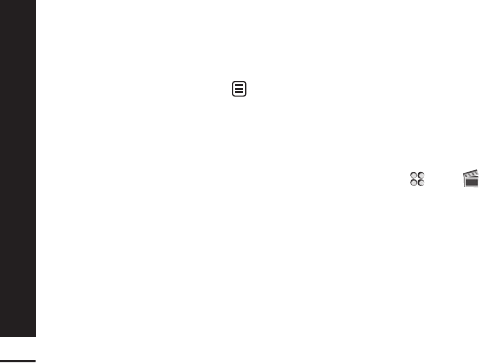
Get creative
62
Sending a video clip
1. Select a video and touch .
2. Touch Send and choose from Message,
Email or Bluetooth.
3. If you choose Message or Email,
your video clip will be attached to the
message and you can write and send
the message as normal. If you choose
Bluetooth, you will be prompted to turn
Bluetooth on and your phone will search
for a device to send the video to.
Using the video options menu
From the My videos folder, you can
choose from the following options:
° Send: Send a video to a friend.
° Move: Move a video clip from the phone
memory to a memory card or vice versa.
° Copy: Copy a video clip from the phone
memory to a memory card or vice versa.
° Delete: Delete a video.
° Rename: Rename a video.
° Create new folder: Create a new folder
within the My videos folder.
° Sort by: Sort videos into order by Date,
Type or Name.
° List view/ Grid view: View the menu by
list type or grid type.
° Folder info.: View the information of
each folder.
° Memory manager: View the memory
status.
° Delete all: Delete all videos.
Games and Applications
You can download new games and
applications to your phone to keep you
amused when you have time to spare.
Playing a game
1. Touch then Entertainment.
2. Touch Games & Apps.
3. Touch My games and apps.
4. Touch Games or Applications folder.
5. Choose and touch a game or an
application to launch.
Using the options menu
Within Games and Application folders,
the following options are available:
° Create new folder: Create a folder
within Games or Applications
° Sort by: Sort the games and applications
by Date, Size or Name.
° Memory manager: View the memory
status handset or external memory.

Get creative
63
Installing a Java game and
application
1. Touch then Entertainment.
2. Touch My stuff then Others or My memory
card. If you insert new memory card, you
can select My memory card menu.
3. Select the file(*.jad or *.jar) you want to
install and touch Install.
Flash contents
The Flash contents folder contains all of
your default and downloaded SWF files.
Viewing an SWF file
1. Touch then Entertainment.
2. Touch My stuff then Flash contents.
3. Select the file to view.
Using options while viewing the
SWF file
Touch and choose from:
° Play/Pause: Play or pause the flash file.
° Mute: Switch the sound off.
° Send: Send the file as a MMS, Email or
via Bluetooth.
° Main screen theme: Set the file as your
wallpaper.
° File info.: View the Name, Size, Date,
Time, Type and Protection of the file.
° Delete: Remove the selected file.
Documents
From the Documents menu, you can view
all of your document files. From here you
can view Excel, Powerpoint, Word, Text and
pdf files. You can use the fingers
diagonally on document to zoom in or
zoom out.
Transferring a file to your phone
Bluetooth is probably the easiest way to
transfer a file from your computer to your
phone. You can also use LG PC Suite via
your sync cable.
To transfer using Bluetooth:
1. Make sure your phone and computer
have Bluetooth switched on and are
visible to one another.
2. Use your computer to send the file via
Bluetooth.
3. When the file is sent you will have to
accept it on your phone by touching
Yes.
4. The file should appear in your
Documents or Others folder.
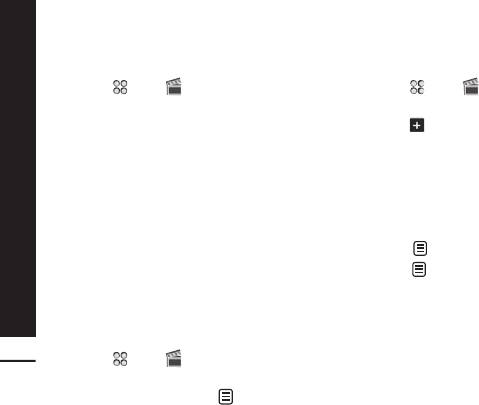
Get creative
64
Viewing a file
1. Touch then Entertainment.
2. Touch My stuff then Documents.
3. Select a document and touch View.
Others
The Others folder is used to store files
which are not pictures, sounds, videos,
games or applications. It is used in the
same way as the Documents folder. You
may find that when you transfer files from
your computer to your phone that they
appear in the Others folder rather than
the Documents folder.
If this happens you can move them.
To Move a file from Others to Documents:
1. Touch then Entertainment.
2. Touch My stuff then Others.
3. Select a file and touch .
4. Touch Move, then touch Move again.
Creating a movie
1. Touch then Entertainment.
2. Touch Muvee studio.
3. Touch to add an image. Touch the
images you want to include then select
Insert .
4. Touch style tab to choose a Muvee
style.
5. Touch Play button to see what you’ve
created.
6. Touch then Order to make an order.
7. Touch then Save Location to
choose where to save the movie. Touch
Music type to choose between Use To
Send and Use To Save.

Get creative
65
Music
Your LG GW520 has a built-in music player
so you can play all your favourite tracks.
To access the music player, touch then
Entertainment then Music. From here
you can access a number of folders:
° Recently played: View all of the songs
you have played recently.
° All tracks: Contains all of the songs you
have on your phone.
° Artists: Browse through your music
collection by artist.
° Albums: Browse through your music
collection by album.
° Genres: Browse through your music
collection by genre.
° Playlists: Contains any playlists you
have created.
° Shuffle tracks: Play your tracks in a
random order.
Transferring music onto your
phone
The easiest way to transfer music onto
your phone is via Bluetooth or your sync
cable.
You can also use LG PC Suite, see page 76
for details. To transfer using Bluetooth:
1. Make sure both devices have Bluetooth
switched on and are visible to one
another.
2. Select the music file on the other device
and choose to send it via Bluetooth.
3. When the file is sent you will have to
accept it on your phone by touching
Yes.
4. The file should appear in Music > All
tracks.
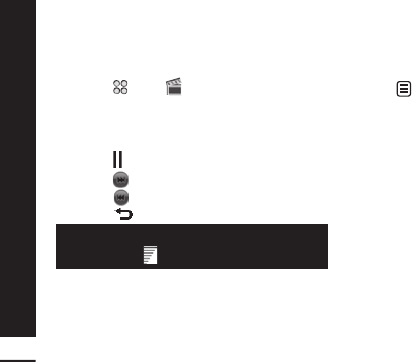
Get creative
66
Playing a song
1. Touch then Entertainment.
2. Touch Music, then All tracks.
3. Select the song you want to play and
touch Play.
4. Touch to pause the song.
5. Touch to skip to the next song.
6. Touch to skip to the previous song.
7. Touch to return to the Music menu.
To change the volume while listening to
music, touch .
Using options while playing music
Touch and choose from:
° Minimize: Make the music player screen
disappear so that you can continue using
your phone as normal.
° Go to my music: View your music files
° Equalizer: Adjust the sound preferences
° Send: Send the song as a message or via
Bluetooth
° Use as: Use the song as a ringtone.
Message tone, Start-up or Shut-down
° File info: View information including the
Name, Size, Date, Time, Type, Duration,
Protection and Copyright of the song.

Get creative
67
Creating a playlist
You can create your own playlists by
choosing a selection of songs from the All
tracks folder.
1. Touch then Entertainment.
2. Touch Music, then Playlists.
3. Touch Add new playlist, enter the
playlist name and touch Save.
4. The All tracks folder will show. Touch
all of the songs that you would like to
include in your playlist; a tick will show
next to the track names.
5. Touch Done.
To play a playlist, select it and touch Play.
To add a second playlist, touch Add new
playlist.
Editing a playlist
From time to time, you may want to add
new songs or delete songs from a playlist.
When you want to do this, you can edit the
playlist.
1. Touch then Entertainment.
2. Touch Music, then Playlists.
3. Select the playlist.
4. Touch and select:
° Add new songs: To add more songs to
the playlist. Mark the ones you want and
touch Done.
° Remove: Remove a song from the
playlist. Touch Yes to confirm.
° Memory status: View the memory
status.
° Remove all: Remove all tracks from the
playlist.
Deleting a playlist
1. Touch then Entertainment.
2. Touch Music, then Playlists.
3. Touch then Delete or Delete all to
delete all of the playlists.

Using the radio
Your LG GW520 has an FM radio feature so
you can tune into your favourite stations
to listen to on the move.
You will need to insert your headphones
in order to listen to the radio. Insert them
into the headphone socket (this is the
same socket that you plug your charger
into).
Searching for stations
You can tune radio stations into your
phone by searching for them either
manually or automatically. They will then
be saved to specific channel numbers so
you don’t have to keep re-tuning. You can
save up to 50 channels in your phone.
To auto tune:
1. Touch then Entertainment.
2. Touch FM radio then .
3. Touch Auto scan then Yes. The stations
found will automatically be allocated to
channel numbers in your phone.
You can also manually tune into a station
by using and displayed next to the
radio frequency or dragging the tuner on
the touch screen.
You can also search next station by using
and .
Resetting channels
1. Touch then Entertainment.
2. Touch FM radio then .
3. Choose Reset to reset the current
channel or choose Reset all to reset all
of the channels. Each channel will return
to the starting 87.5Mhz frequency.
Listening to the radio
1. Touch then Entertainment.
2. Touch FM radio then touch the channel
number of the station you would like to
listen to.
To improve the radio reception, extend
the headset cord, which functions as the
radio antenna.
Get creative
68
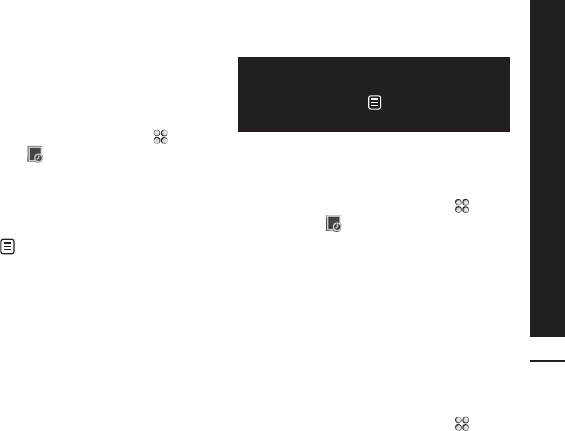
Get organised
69
ORGANISER
Adding an event to your calendar
1. From the standby screen select ,
then touch Utilities and choose
Organiser.
Select Calendar.
2. Select the date you would like to add an
event to.
3. Touch then Add event.
4. Touch Category then choose from
Appointment, Anniversary or
Birthday.
Check the date and enter the time you
would like your event to begin.
5. For appointments and anniversaries
enter the time and date your event
finishes in the lower two time and date
boxes.
6. If you would like to add a subject or a
note to your event, touch Note and
type in your note, followed by Save.
7. Set Alarm and Repeat.
8. Select Save and your event will be
saved in the calendar. A square cursor
will mark the day that any events have
been saved to and a bell will ring at the
start time of your event, so that you can
stay organised.
You can set a holiday in your calendar.
Touch each day you are on holiday one
at time, then touch and select Set
holiday. Each day will be shaded red.
Changing your default calendar
view
1. From the standby screen select ,
then touch Utilities and choose
Organiser.
Select Settings.
2. Touch Calendar and choose either
Month view or Week view in Default
view menu.
3. Set Week starts on to start the day of
week.
4. Press Save to confirm your choice.
Adding an item to your to do list
1. From the standby screen select , then
touch Utilities and choose Organiser.
2. Select Add to do.
3. Set the date for the to do item, add
notes and select a priority level: High,
Medium or Low.
4. Save your to do list item by selecting
Save.
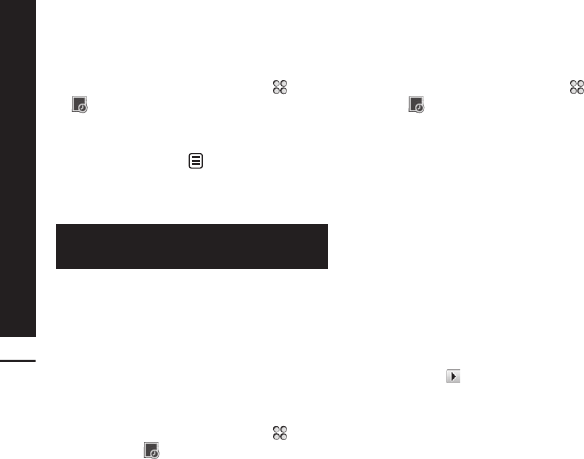
Get organised
70
Sharing a to do item
1. From the standby screen select , then
Utilities and choose Organiser.
Select To d o.
2. Select the to do item you would like to
share, then touch .
3. Select Send. You can choose to share
your to do item by Text message,
Multimedia msg., Email or Bluetooth.
Tip: You can back up and synchronise
your calendar with your computer.
Using date finder
Date finder is a handy tool to help you
calculate what the date will be after a
certain amount of days has passed. For
example, 60 days from 10.10.07 will be
09.12.2007.
This is great for keeping tabs on deadlines.
1. From the standby screen select ,
then touch Utilities and choose
Organiser.
2. Select Date finder.
3. In the From tab set your required date.
4. In the After tab set the number of days.
5. The Target date will be shown below.
Setting your alarm
1. From the standby screen select , then
touch Utilities and choose Alarms.
2. Touch Add alarm.
3. Set the time you would like the alarm to
sound and touch Set time.
4. Choose whether you would like your
alarm to repeat Once, Daily, Mon - Fri,
Mon - Sat, Sat - Sun, Except holiday or
Choose weekday.
The icons indicate the weekday you
select.
5. Select Set alarm type to select a type
for your alarm.
6. Touch Alarm tone then choose a sound
from My sounds or My memory card.
To listen to sounds touch the sound,
followed by .
7. Add a memo for the alarm. Touch Save
when you have finished typing the
memo.
8. Finally you can set the snooze interval
at 5, 10, 20, 30 minutes, 1hour or off.
9. Once you have set your alarm, touch
Save.

Get organised
71
Adding a memo
1. From the standby screen select ,
then touch Utilities and choose Add
Memo.
2. Type your memo, followed by Save.
3. Your memo will appear on screen next
time you open the Memo application.
You can edit an existing memo. Select
the one you want to edit and type your
changes.
Voice recorder
Use your voice recorder to record voice
memos or other sounds.
1. Touch then Utilities.
2. Touch Voice recorder then and
choose from:
° Settings
- Duration: Set the recording duration.
Choose from MMS message size, 1
minute or No limit.
- Quality: Select the sound quality.
Choose from Super Fine, Fine or
Normal.
- Memory in use: Check the current
status of memory.
° Go to my sounds: Open the Voice
recordings folder in My sounds.
Recording a sound or voice
1. Touch then Utilities.
2. Touch Voice recorder.
3. Touch to begin recording.
4. Touch to end recording.
5. Touch to listen to your recording.

Get organised
72
Sending the voice recording
1. Once you have finished recording, touch
.
2. Touch Send via and choose from
Message, Email or Bluetooth. If
you choose Message or Email, the
recording will be added to the message
and you can write and send it as normal.
If you choose Bluetooth, you will be
prompted to turn Bluetooth on.
After you have finished recording, touch
and choose Send via, File > Rename,
Delete, Use as (to use the recording
as your ringtone Settings) or Go to my
sounds.
Using your calculator
1. From the standby screen select , then
touch Utilities and choose Tools.
2. Select Calculator.
3. Touch the numeric keys to input
numbers.
4. For simple calculations, touch the
function you require (+, –, *, /), followed
by =.
5. For more complex calculations, touch
and choose from sin, cos, tan, log,
ln, exp, deg or rad etc..
Converting a unit
1. From the standby screen select , then
touch Utilities and choose Tools.
2. Select Converter.
3. Choose whether you would like to
convert Currency, Surface, Length,
Weight, Temperature, Volume or
Velocity.
4. You can then select the unit, and enter
the value you would like to convert
from, followed by the unit you would like
to convert to.
5. The corresponding value will appear on
the screen.
Using the stopwatch
1. From the standby screen select , then
touch Utilities and choose Tools.
2. Select Stopwatch.
3. Touch Start to begin the timer.
4. Touch Lap if you want to record a lap
time.
5. Touch Stop to end the timer.
6. Touch Resume to restart the stopwatch
at the time you stopped it at, or touch
Reset to begin the time again.

Get organised
73
Adding a city to your world time
1. From the standby screen select , then
touch Utilities and choose Tools.
2. Select World time.
3. Touch the icon, followed by Add city.
Start searching the city you require.

Get organised
74
PC SYNC
You can synchronise your PC with your
phone to make sure all your important
details and dates match, but also to
backup your files to put your mind at ease.
Installing LG PC Suite on your
computer
1. From the standby screen select , then
Settings.
2. Select Connectivity, then USB
connection mode.
3. Touch PC suite.
4. Insert the supplied CD into your PC. Click
on the LG PC suite Installer which will
appear on your screen.
5. Select the language you would like the
installer to run in and click OK.
6. Follow the instructions on screen to
complete the LG PC Suite Installer
wizard.
7. Once installation is complete, the LG PC
Suite icon will appear on your desktop.
Connecting your phone and PC
1. Connect the USB cable to your phone
and your PC.
2. Double click on the LG PC Suite icon on
your desktop.
3. Click on Connection Wizard, then USB.
4. Click on Next, then Next again, then
Finish.
Your phone and PC are now connected.
Backing up and restoring your
phone’s information
1. Connect your phone to your PC as
outlined above.
2. Click on the Backup icon, and select
Backup or Restore.
3. Mark the contents you would like to
back up or restore. Select the location
you would like to backup information to,
or restore information from. Click OK.
4. Your information will be backed up.

Get organised
75
Viewing your phone files on your
PC
1. Connect your phone to your PC as
outlined above.
2. Click on the Contents icon.
3. All of the documents, flash contents,
images, sounds and videos you have
saved onto your phone will be displayed
on the screen in the LG Phone folder.
Viewing the contents of your phone
on your PC helps you to arrange files,
organise documents and remove
contents you no longer need.
Synchronising your contacts
1. Connect your phone to your PC.
2. Click on the Contacts icon.
3. Your PC will now import and display all
contacts saved to your USIM card and
handset.
4. Click on File and select Save. You can
now select where you would like to save
your contacts to.
To backup contacts saved to your USIM
card, click on the SIM card folder on the
left side of your PC screen. Select Edit at
the top of the screen, then Select all.
Right-click your contacts and select
Copy to contact. Now click on the
Handset folder on the left of your screen
and all your numbers will be displayed.
Synchronising your messages
1. Connect your phone to your PC.
2. Click on the Messages icon.
3. All of your PC and phone messages will
be displayed in folders on your screen.
4. Use the tool bar at the top of your
screen to edit and rearrange messages.
Using your phone as a mass
storage device
Your phone can only be used as a mass
storage device if you have a memory card
inserted.
1. Disconnect your phone from your PC.
2. From the standby screen select ,
then touch Settings .
3. Select Connectivity, then USB
connection mode.
4. Touch Mass storage.
5. Connect your phone to your PC. Your
phone will read: Connecting as Mass
Storage… followed by Connected as
Mass Storage Mode. Do not disconnect
during transfer.
6. All of your phone files will automatically
be stored onto your PC hard drive.
Your phone must be unplugged from your
PC to initiate Mass Storage.

Get organised
76
Mass storage backs up content saved on
your memory card only, not your handset
memory. To transfer the content of your
handset memory (e.g. contacts) you’ll
need to synchronise using PC Sync.
Using iSync
Install the iSync plug-in install file which
is supported between Machintoshi PC
and phone via Bluetooth or USB. Use the
GW520.pkg program is supplied on the CD.
To synchronise via Bluetooth, you have
to set up pairing between Machintoch PC
and phone. If you want to set up via USB,
select iSync menu in USB connection
mode.
DivX Converter
Install the DivX converter which is supplied
on the same CD as the PC Sync software.
Once installed select DivX from the
Program Files on your PC, then DivX
converter followed by Converter.
This will open the Converter application.
Use the arrows in the application to
change the conversion format to Mobile.
If you right click on the application box
and select Preferences, you can change
the location of where the converted files
are saved.
Once you are ready to convert your files,
simply drag and drop the files into the
application, for initial analysis. Following
this, you will need to select Convert for
the process to begin. When the process is
finished a Conversion complete pop up will
be displayed.
The converted file can now be transferred
to your phone, using the Mass Storage
functionality (see page 77 for details)
or Upload contents using the PC Sync
software.

The web
77
THE WEB
Browser
Browser gives you a fast, full colour
world of games, music, news, sport,
entertainment and loads more, straight
to your mobile phone. Wherever you are
and whatever you’re into. You can view the
pages with the fingers diagonally to zoom
in or out.
Accessing the web
1. From the standby screen select , then
touch Utilities and choose Browser.
2. To access the browser homepage
directly, select Home. Alternately select
Enter address and type in your desired
URL, followed by Connect.
An additional cost is incurred when
connecting to this service and
downloading content. Check your data
charges with your network provider.
Adding and accessing your
bookmarks
For easy and fast access to your favourite
websites, you can add bookmarks and
save web pages.
1. From the standby screen select , then
touch Utilities and choose Browser.
2. Select Bookmarks. A list of your
Bookmarks will appear on the screen.
3. To add a new bookmark, touch Add
bookmark. Enter a name for your
bookmark followed by the URL.
4. Touch Save. Your Bookmark will now
appear in the list of bookmarks.
5. To access the bookmark simply touch
the bookmark and then touch connect.
You will be connected to your bookmark.

The web
78
Using RSS reader
RSS (Really Simple Syndication) is a
family of web feed formats used to publish
frequently updated content such as blog
entries, news headlines or forecasts. An
RSS document, which is called a feed,
web feed, or channel, contains either a
summary of content from an associated
web site or the full text. RSS makes it
possible for people to keep up with their
favourite web sites in an automated
manner that is easier than checking them
manually.
The user subscribes to a feed by entering
the feed’s link into the reader or by clicking
an RSS icon in a browser that initiates the
subscription process. The reader checks
the user’s subscribed feeds regularly for
new content, downloading any updates
that it finds.
Saving a page
1. Access your required webpage as
described above.
2. Touch and select Save this page.
3. Enter a name for the webpage so you
can easily recognise it.
4. Touch Save.
Accessing a saved page
1. From the standby screen select , then
touch Utilities and choose Browser.
2. Select Saved pages.
3. Select the required page and it wil open.
Viewing your browser history
1. From the standby screen select , then
touch Utilities and choose Browser.
Select History.
2. A list of web page titles you have
accessed recently will be displayed. To
access one of these pages, simply select
the required page.

Changing the web browser settings
1. From the standby screen select , then
touch Utilities and choose Browser.
Select Settings.
2. You can choose to edit Profiles,
Appearance settings, Cache, Cookies,
Security, or to reset all settings, select
Reset Settings.
3. You can simply set these to on or off by
touching the icon.
Using your phone as a modem
Your GW520 can double as a modem for
your PC, giving you email and internet
access even when you can’t connect using
wires. You can use either the USB cable or
Bluetooth.
Using the USB cable:
1. Ensure you have the LG PC Suite
installed on your PC.
2. Connect your GW520 and your PC using
the USB cable and launch the LG PC
Suite software.
3. Click Communicate on your PC. Then
click Settings and select Modem.
4. Choose LG Mobile USB Modem and
select OK. It will now appear on screen.
5. Click Connect and your PC will connect
through your GW520.
For more information on synchronising
using the LG PC Suite see page 77.
Using Bluetooth:
1. Ensure Bluetooth is switched On and
Visible for both your PC and GW520.
2. Pair your PC and GW520 so that a
passcode is required for connection.
3. Use the Connection wizard on your LG
PC Suite to create an active Bluetooth
connection.
4. Click Communicate on your PC. Then
click Setting.
5. Click Modem.
6. Choose Standard Modem over
Bluetooth link and click OK. It will now
appear on screen.
7. Click Connect and your PC will connect
through your GW520.
For more information on Bluetooth see
page 85.
The web
79

SETTINGS
Within this folder you can adapt your
settings to make your GW520 personal
to you.
For information on call settings see page
28.
Changing your screen settings
1. Touch then choose Settings.
2. Touch Screen settings and then choose
from:
° Wallpaper: Choose the theme for your
standby screen.
° Top menu: Phone displays menu in
standby.
° Dialling: Adjust the number size and
colour.
° Font: Adjust the font size.
The longer the backlight is on for, the
more battery power is used and you may
need to charge your phone more often.
° Backlight: Choose how long the
backlight remains on for.
° Brightness: Adjust the screen brightness.
° Handset theme: Quickly change the
whole look of your screen.
° Greeting message: Choose on or off and
fill in the greeting message.
3. Touch Save to save your settings.
Personalising your profiles
You can quickly change your profile on the
standby screen. Simply touch the status
summary bar on the top and touch the
profile tab.
Using the settings menu you can
personalise each profile setting.
1. Press and then choose Settings.
2. Touch Profiles and then choose the
profile you want to edit.
3. You can then change all of the sounds
and alert options available in the list,
including your Voice/Video call ring tone
and volume, message alerts, screen
sound settings and more.
Changing your phone settings
Enjoy the freedom of adapting how your
GW520 works to your own preferences.
To scroll through a list of options, touch
the last item visible and slide your finger
up the screen. The list will move up so
more items are visible.
1. Touch then choose Settings.
2. Touch Phone settings then choose
from the list below.
° Date & Time: Adjust your date and time
settings or choose to auto update the
time when you travel or for daylight
saving.
Settings
80

Settings
81
° Power save: Choose to switch the
factory set power saving settings On, Off
and Auto.
° Languages: Change the language of
your GW520’s display.
° Autokeylock: Lock the keypad
automatically in standby screen.
° Security: Adjust your security settings,
including PIN codes and handset lock.
° Memory manager: See Using memory
manager on page 84 for more
information.
° Reset settings: Reset all the settings to
their factory definitions.
° Information: View the technical
information for your GW520.
Changing the setting of touchpad
You can change the setting value of
touchpad. Touch and then choose
Touch settings.
° Touch type: Change the touching type
such as vibration, tone, vibration & tone,
No feedback.
° Touch tone: Change the tone when
touching the screen.
° Tone volume: Controls the volume of
tone.
° Touch vibration: Change the type of
vibration
° Vibration volume: Controls the strength
of vibration.
Changing your connectivity
settings
Your connectivity settings have already
been set up by your network operator, so
you can enjoy your new phone from the
off. If you want to change any settings, use
this menu.
Touch then Settings. Touch
Connectivity.
° Network settings: Your GW520
connects automatically to your preferred
network.
To change these settings use this menu.
° Internet profiles: Set the profiles to
connect to the internet.
° Access points: Your network operator has
already saved this information. You can
add new access points using this menu.
° Packet data conn.: Set the packet data
connection.
° USB connection mode: Choose PC suite
and synchronise your GW520 using the
LG PC Suite software to copy files from
your phone.
If you use Music sync with Windows
Media Player, select Music sync in this
menu. Music sync is only available for
music content. You can synchronize data
with external memory card or Phone
Internal memory or both.
Choose PictBridge to print out the data in
My stuff menu. Always ask means that
the menu will always offer a choice of

Settings
82
USB connections.
° TV out: Choose PAL or NTSC for
connecting your GW520 to a TV.
° Synch service: The Server sync function
synchronises the data in a phone and the
data on a server such as contact address
information, schedule items, to do items
and memo items via a wireless network.
Synch service is dependent upon the
network service.
° Streaming settings: Your network
operator has already saved this
information. You may edit it if you’d like
to make changes.
° Divx VOD registration: Install the DivX
converter which is supplied on the same
CD as the PC Sync software.
Once installed select DivX from the
Program Files on your PC, then DivX
converter followed by Converter.
The TV output cable is available for
purchase separately.
- ABOUT DIVX VIDEO: DivX® is a digital
video format created by DivX, Inc. This
is an official DivX Certified device that
plays DivX video.
- ABOUT DIVX VIDEO-ON-DEMAND:
This DivX® Certified device must
be registered with DivX in order to
play DivX Video-on-Demand (VOD)
content. First generate the DivX VOD
registration code for your device
and submit it during the registration
process. [Important: DivX VOD content
is protected by a DivX DRM (Digital
Rights Management) system that
restricts playback to registered DivX
Certified devices. If you try to play DivX
VOD content not authorized for your
device, the message “Authorization
Error” will be displayed and your
content will not play.] Learn more at
www.divx.com/vod.
Using memory manager
Your GW520 has three memories
available: the phone, the USIM Card and an
external memory card (you may need to
purchase the memory card separately).
You can use memory manager to
determine how each memory is used and
see how much space is available.
Touch followed by Settings. Select
Phone settings then Memory Manager.

Settings
83
° Handset common memory: View the
memory available on your GW520 for
Pictures, Sounds, Video, Flash, MMS,
Email, Java applications and others.
° Handset reserved memory: View the
memory available on your handset for
SMS, Contacts, Calendar, To do list,
Memo, Alarm, Call history, Bookmarks
and Miscellaneous items.
° SIM memory: View the memory available
on your USIM Card.
° External memory: View the memory
available on your external memory card
(you may need to purchase the memory
card separately).
° Primary storage settings: Choose the
location you prefer items to be saved to.
See page 14 for information on Installing
a memory card.
Using flight mode
Turn on flight mode by selecting then
Settings. Touch Profiles and choose
Flight mode.
Flight mode will not allow you to make
calls, connect to the Internet, send
messages or use Bluetooth.
Sending and receiving your files
using Bluetooth
Bluetooth is a great way to send and
receive files as no wires are needed and
connection is quick and easy. You can also
connect to a Bluetooth headset to make
and receive calls.
To send a file:
1. Open the file you want to send, typically
this will be a photo, video or music file.
2. Touch and choose Send.
Choose Bluetooth.
3. If you have already paired the
Bluetooth device, your GW520 will
not automatically search for other
Bluetooth devices. If not, your GW520
will search for other Bluetooth enabled
devices within range.
4. Choose the device you want to send the
file to and touch Select.
5. Your file will be sent.
Keep an eye on the progress bar to make
sure your file is sent.
To receive a file:
1. To receive files your Bluetooth must
be both On and Visible. See change
your Bluetooth settings below for more
information.
2. A message will prompt you to accept
the file from the sender. Touch Yes to
receive the file.

Settings
84
3. You will see where the file has been
saved and you can choose to View
the file or Use as wallpaper. Files will
usually be saved to the appropriate
folder in your Media Album.
Changing your Bluetooth settings:
1. Touch and choose Settings.
2. Choose Bluetooth then touch and
choose Settings. Make your changes to:
° My device visibility: Choose to be
Visible or Hidden or Visible for 1 min.
° My device name: Enter a name for your
GW520.
° Supported services: Choose how to use
Bluetooth in association with different
services.
° Remote SIM Mode: On /Off
° My address: Show your Bluetooth
address.
Pairing with another Bluetooth
device
By pairing your GW520 and another
device, you can set up a passcode
protected connection. This means your
pairing is more secure.
1. Check your Bluetooth is On and Visible.
You can change your visibility in the
Settings menu.
2. Touch Search.
3. Your GW520 will search for devices.
When the search is completed Refresh
will appear on screen.
4. Choose the device you want to pair with
and enter the passcode, then touch OK.
5. Your phone will then connect to the
other device, on which you should enter
the same passcode.
6. You passcode protected Bluetooth
connection is now ready.
Using a Bluetooth headset
1. Check your Bluetooth is On and Visible.
2. Follow the instructions that came with
your headset to place your headset in
pairing mode and pair your devices.
3. Touch Ask always or Allow without
ask and touch Yes to Connect now Your
GW520 will automatically switch to
Headset profile.
See page 28 for details on BT answer
mode so that you can control how you
answer calls when your Bluetooth
headset is connected.

WIFI
Wireless Manager allows you to manage
Wi-Fi Internet on your device. It allows
the phone to connect to local wireless
networks, or access the Internet wirelessly.
Wi- Fi is faster and has a greater range
than Bluetooth wireless technology.
GW520 supports WEP, WPA-PSK/2
encryption not EAP, WPS encryption. If
your Wi-Fi service provider or network
administrator sets the encryption
for network security, you should fill
in the key in the pop-up window. If
the encryption is not set, this pop-up
window is not shown. If you don’t know
the key, you need to ask for it from
your Wi-Fi service provider or network
administrator.
Settings
85